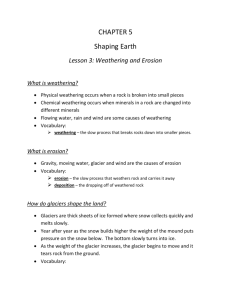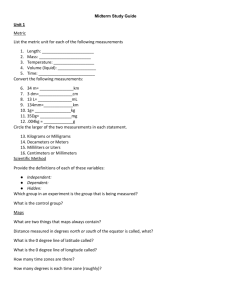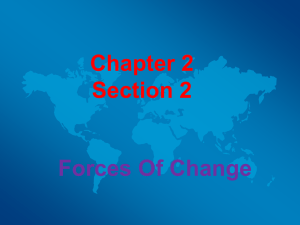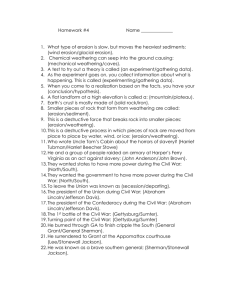Word - New Haven Science
advertisement
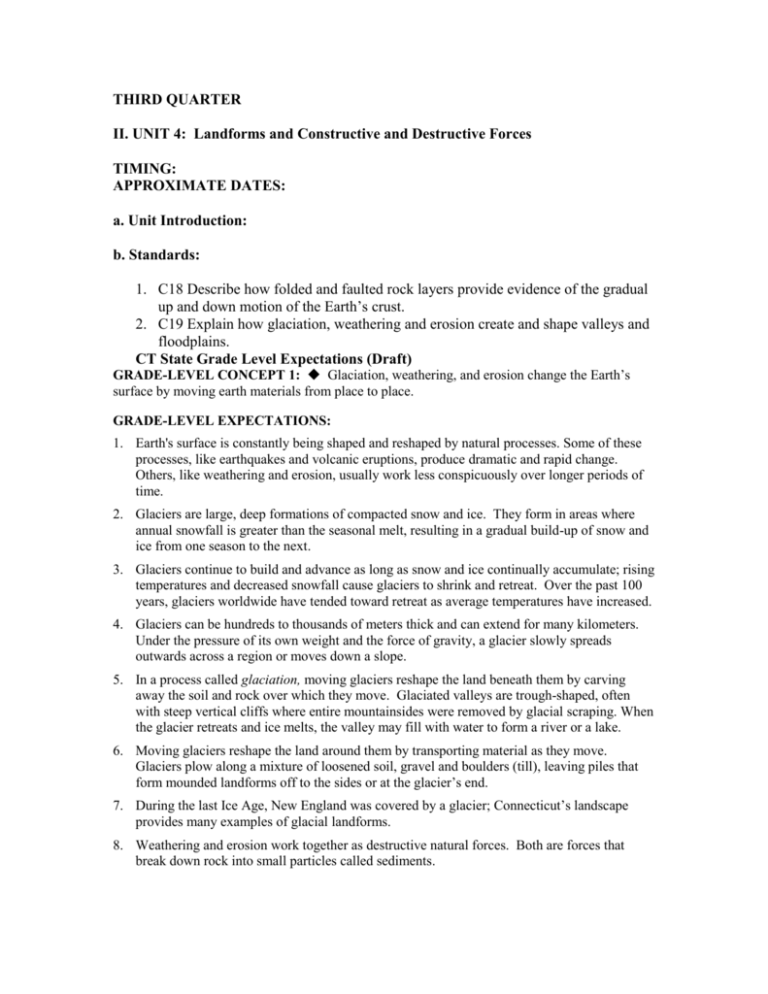
THIRD QUARTER II. UNIT 4: Landforms and Constructive and Destructive Forces TIMING: APPROXIMATE DATES: a. Unit Introduction: b. Standards: 1. C18 Describe how folded and faulted rock layers provide evidence of the gradual up and down motion of the Earth’s crust. 2. C19 Explain how glaciation, weathering and erosion create and shape valleys and floodplains. CT State Grade Level Expectations (Draft) GRADE-LEVEL CONCEPT 1: Glaciation, weathering, and erosion change the Earth’s surface by moving earth materials from place to place. GRADE-LEVEL EXPECTATIONS: 1. Earth's surface is constantly being shaped and reshaped by natural processes. Some of these processes, like earthquakes and volcanic eruptions, produce dramatic and rapid change. Others, like weathering and erosion, usually work less conspicuously over longer periods of time. 2. Glaciers are large, deep formations of compacted snow and ice. They form in areas where annual snowfall is greater than the seasonal melt, resulting in a gradual build-up of snow and ice from one season to the next. 3. Glaciers continue to build and advance as long as snow and ice continually accumulate; rising temperatures and decreased snowfall cause glaciers to shrink and retreat. Over the past 100 years, glaciers worldwide have tended toward retreat as average temperatures have increased. 4. Glaciers can be hundreds to thousands of meters thick and can extend for many kilometers. Under the pressure of its own weight and the force of gravity, a glacier slowly spreads outwards across a region or moves down a slope. 5. In a process called glaciation, moving glaciers reshape the land beneath them by carving away the soil and rock over which they move. Glaciated valleys are trough-shaped, often with steep vertical cliffs where entire mountainsides were removed by glacial scraping. When the glacier retreats and ice melts, the valley may fill with water to form a river or a lake. 6. Moving glaciers reshape the land around them by transporting material as they move. Glaciers plow along a mixture of loosened soil, gravel and boulders (till), leaving piles that form mounded landforms off to the sides or at the glacier’s end. 7. During the last Ice Age, New England was covered by a glacier; Connecticut’s landscape provides many examples of glacial landforms. 8. Weathering and erosion work together as destructive natural forces. Both are forces that break down rock into small particles called sediments. 9. Weathering is the breakdown of rocks into small particles (sediment) due to physical, chemical, or biological interactions. Physical weathering can result from the repeated freezing and thawing of water entering small cracks or pores in rocks, or from temperature fluctuations causing expansion and contraction. Chemical weathering can occur when water dissolves minerals in certain rock types. Biological weathering can be caused by plant roots or lichens. Rock properties, such as hardness, porosity or mineral content, influence its susceptibility to weathering. 10. Erosion loosens and transports sediment formed by weathering. Moving water can carry away tiny sediments or entire hillsides, riverbanks, beaches, or roadbeds. Rivers, waves or waterfalls can carve landforms such as valleys, canyons, caverns or floodplains. Wind can erode some rock types, carving distinctive formations or creating sand dunes. CONTENT STANDARD 7.3 – continued GRADE-LEVEL CONCEPT 2: Volcanic activity and the folding and faulting of rock layers during the shifting of Earth’s crust affect the formation of mountains, ridges, and valleys. GRADE-LEVEL EXPECTATIONS: 1. Earth’s surface features, such as mountains, volcanoes and continents, are the constantlychanging result of dynamic processes and forces at work inside the Earth. 2. Earth is formed of three basic layers, with the densest being the iron and nickel core. The middle layer, the mantle, of the Earth is composed of mostly light elements such as silicon, oxygen and magnesium and is quite plastic because of its high temperature and pressure. The top layer, the crust, is solid but relatively thin, and it supports large land masses (continents) and oceans. 3. The material supporting the earth’s crust is broken into different “tectonic plates” that float on the material beneath it and move in small amounts very slowly. Continental drift is driven by convection currents in the hot liquid mantle beneath the crust. 4. The presence of plant and animal fossils of the same age found around different continent shores, along with the matching coastline shapes of continental land masses, provides evidence that the continents were once joined. 5. At the locations where two tectonic plates interact, a boundary exists. There are divergent boundaries (where plates move apart causing trenches and new crust to form), convergent boundaries (where plates push together causing folding, faulting and uplift), and transform boundaries (where plates slide past each other causing a build-up of resistance that can result in earthquakes). Connecticut has a great deal of fault rock evidence of crustal separation. 6. The folding and faulting of rock layers during the shifting of the Earth’s crust causes the constructive formation of mountains, ridges and valleys. 7. Mountain formation can be the result of convergent tectonic plates colliding, such as the Appalachians and the Himalayas; mountains may also be formed as a result of divergent tectonic plates moving apart and causing rifting as in East Africa or Connecticut. 8. Most volcanoes and earthquakes are located at tectonic plate boundaries where plates come together or move apart from each other. A geographic plot of the location of volcanoes and the centers of earthquakes allows us to locate tectonic plate boundaries. 9. The geological makeup of Connecticut shows evidence of various earth processes, such as continental collisions, rifting, and folding that have shaped its structure. SCIENTIFIC LITERACY TERMINOLOGY: Erosion, weathering, glacier, valley, floodplain, core, mantle, folds, fault/fault line, continent, tectonic plate, plate boundary, convection, mountains, volcano, earthquake. c. Essential Questions: 1. 2. 3. 4. 5. 6. How does stress in the crust change Earth’s surface? What processes wear down and build up the surface of the Earth? What process is mainly responsible for shaping the surface of the land? How do weathering and erosion affect Earth’s surface? How do glaciers cause erosion and deposition? How do scientists determine the relative age of rocks? d. Essential Concept 1. Earth’s outer layer is broken into sections called plates. 2. Stress is created when enormous forces act on rocks to change their shape and volume. 3. A fault is created when enough stress builds up in rock causing the rock to break. 4. Plate movement can cause the crust to fold creating mountains and valleys. 5. Weathering and erosion work together continuously to wear down and carry away the rocks at Earth’s surface. 6. Glaciers are large masses of ice that move slowly over land. 7. As a glacier moves over land, the weight of the ice breaks the rock beneath. When it flows downhill, it scrapes away the bedrock under it and carries rock debris with it. When the glacier melts, it deposits the rock fragment creating various landforms. 8. Scientists use the position of rock layers to determine their relative age. The oldest layers are generally found on the bottom while the younger layers are found on top. e. Essential Skills f. Vocabulary 1. plate 2. stress 3. volume 4. tension 5. compression 6. shearing 7. fold 8. fault 9. normal fault 10. reverse fault 11. strike-slip fault 12. mountain 13. valley 14. weathering 15. mechanical weathering 16. chemical weathering 17. erosion 18. sediment 19. deposition 20. glacier 21. continental glacier 22. valley glacier g. Suggested Labs and Activities How Glaciers Change Land Faults Fault Model How Stress Affects the Earth Mountains 23. relative age
